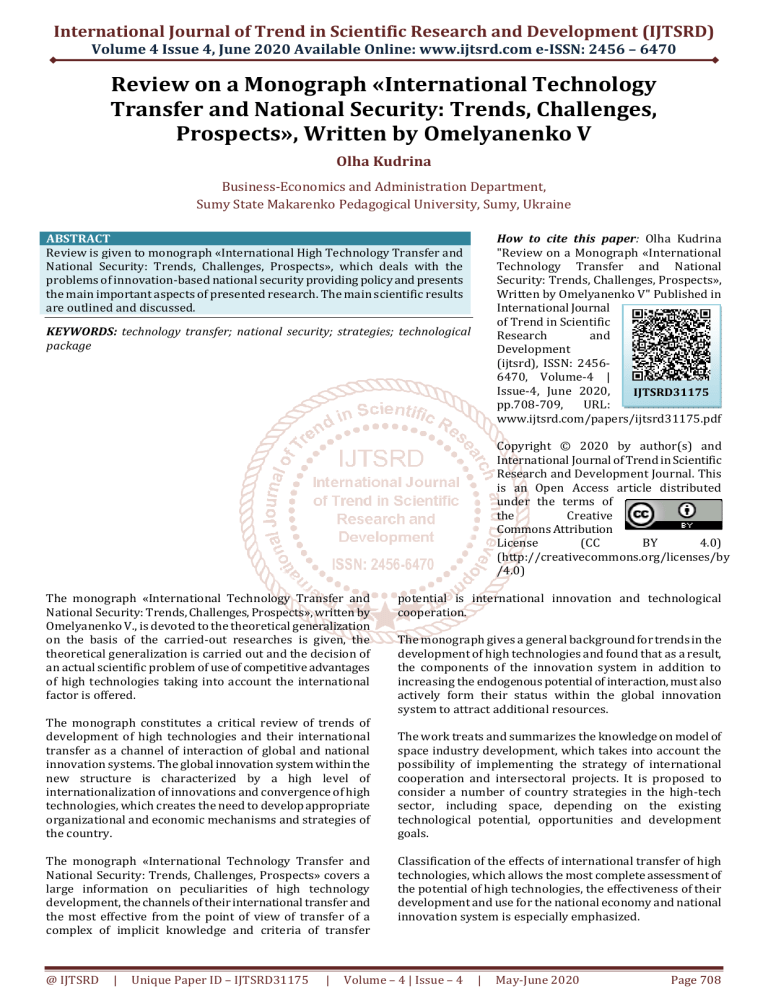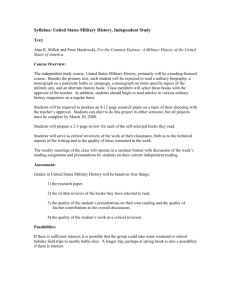
International Journal of Trend in Scientific Research and Development (IJTSRD)
Volume 4 Issue 4, June 2020 Available Online: www.ijtsrd.com e-ISSN: 2456 – 6470
Review on a Monograph «International Technology
Transfer and National Security: Trends, Challenges,
Prospects», Written by Omelyanenko V
Olha Kudrina
Business-Economics and Administration Department,
Sumy State Makarenko Pedagogical University, Sumy, Ukraine
ABSTRACT
Review is given to monograph «International High Technology Transfer and
National Security: Trends, Challenges, Prospects», which deals with the
problems of innovation-based national security providing policy and presents
the main important aspects of presented research. The main scientific results
are outlined and discussed.
How to cite this paper: Olha Kudrina
"Review on a Monograph «International
Technology Transfer and National
Security: Trends, Challenges, Prospects»,
Written by Omelyanenko V" Published in
International Journal
of Trend in Scientific
Research
and
Development
(ijtsrd), ISSN: 24566470, Volume-4 |
Issue-4, June 2020,
IJTSRD31175
pp.708-709,
URL:
www.ijtsrd.com/papers/ijtsrd31175.pdf
KEYWORDS: technology transfer; national security; strategies; technological
package
Copyright © 2020 by author(s) and
International Journal of Trend in Scientific
Research and Development Journal. This
is an Open Access article distributed
under the terms of
the
Creative
Commons Attribution
License
(CC
BY
4.0)
(http://creativecommons.org/licenses/by
/4.0)
The monograph «International Technology Transfer and
National Security: Trends, Challenges, Prospects», written by
Omelyanenko V., is devoted to the theoretical generalization
on the basis of the carried-out researches is given, the
theoretical generalization is carried out and the decision of
an actual scientific problem of use of competitive advantages
of high technologies taking into account the international
factor is offered.
The monograph constitutes а critical review of trends of
development of high technologies and their international
transfer as a channel of interaction of global and national
innovation systems. The global innovation system within the
new structure is characterized by a high level of
internationalization of innovations and convergence of high
technologies, which creates the need to develop appropriate
organizational and economic mechanisms and strategies of
the country.
The monograph «International Technology Transfer and
National Security: Trends, Challenges, Prospects» covers a
large information on peculiarities of high technology
development, the channels of their international transfer and
the most effective from the point of view of transfer of a
complex of implicit knowledge and criteria of transfer
@ IJTSRD
|
Unique Paper ID – IJTSRD31175
|
potential is international innovation and technological
cooperation.
The monograph gives a general background for trends in the
development of high technologies and found that as a result,
the components of the innovation system in addition to
increasing the endogenous potential of interaction, must also
actively form their status within the global innovation
system to attract additional resources.
The work treats and summarizes the knowledge on model of
space industry development, which takes into account the
possibility of implementing the strategy of international
cooperation and intersectoral projects. It is proposed to
consider a number of country strategies in the high-tech
sector, including space, depending on the existing
technological potential, opportunities and development
goals.
Classification of the effects of international transfer of high
technologies, which allows the most complete assessment of
the potential of high technologies, the effectiveness of their
development and use for the national economy and national
innovation system is especially emphasized.
Volume – 4 | Issue – 4
|
May-June 2020
Page 708
International Journal of Trend in Scientific Research and Development (IJTSRD) @ www.ijtsrd.com eISSN: 2456-6470
The analysis of efficiency of the international transfer of high
technologies needs to be carried out proceeding from the
analysis of the technological package integrating a complex
of technologies and gives the chance to realize a certain
macroproject. The theoretical bases of technological package
management are considered in the work, the basic
tendencies are analyzed and the basic tasks of management
of development of space branch as the international
interbranch high-tech complex on the basis of the concept of
technological package are defined. The main tool of
international innovation and technology cooperation, which
ensures the implementation of the principles of parallel
development of the components of the technological package
and meets the needs of intersectoral cooperation, are
international clusters and intercluster relations.
According to the proposed approaches to the optimization of
the technological package of the high-tech industry in terms
of internationalization of technology transfer and the
developed criteria for evaluating the technological package,
the analysis of the space industry of Ukraine and space
@ IJTSRD
|
Unique Paper ID – IJTSRD31175
|
instrumentation. The obtained calculations showed that the
international aspect is the most important at the design and
operation stage. At these stages, it is advisable to implement
a system of selective development based on foresight and
develop an effective mechanism for intersectoral
cooperation.
The information in monograph «International Technology
Transfer and National Security: Trends, Challenges,
Prospects» is given as part of synthetic whole. The chapters
provide interesting reading due to the original approach and
rich contents. The main achievement of the work lies in a
very profound treatment of the applied material. The
coverage of monograph is extremely wide.
Some omissions are, however, incidental and in nо way
prevent the book being a most stimulating and useful. Any
attempt to continue the investigation is to be warmly
welcomed. The work under review is an outstanding
achievement of economic science.
Volume – 4 | Issue – 4
|
May-June 2020
Page 709


